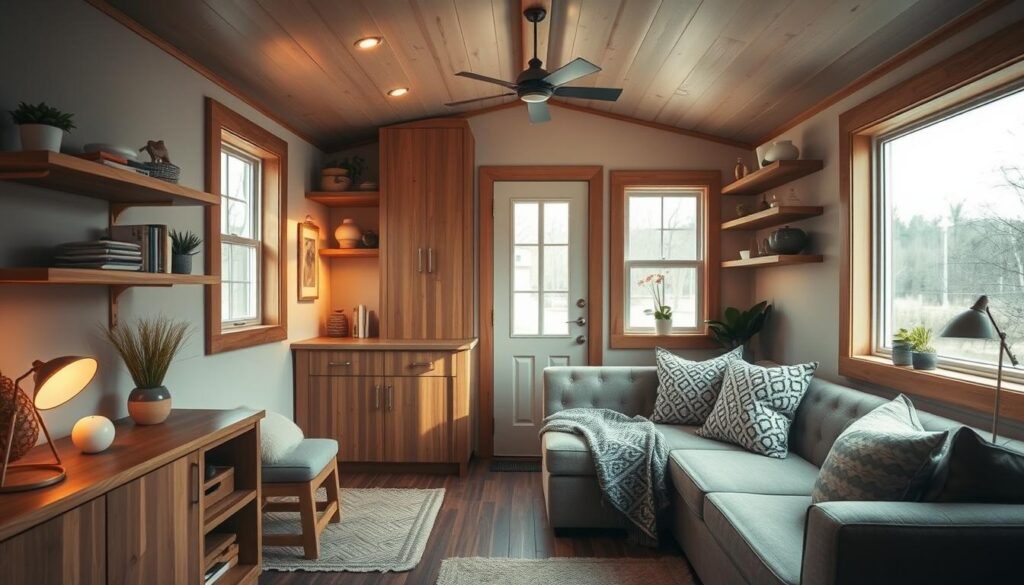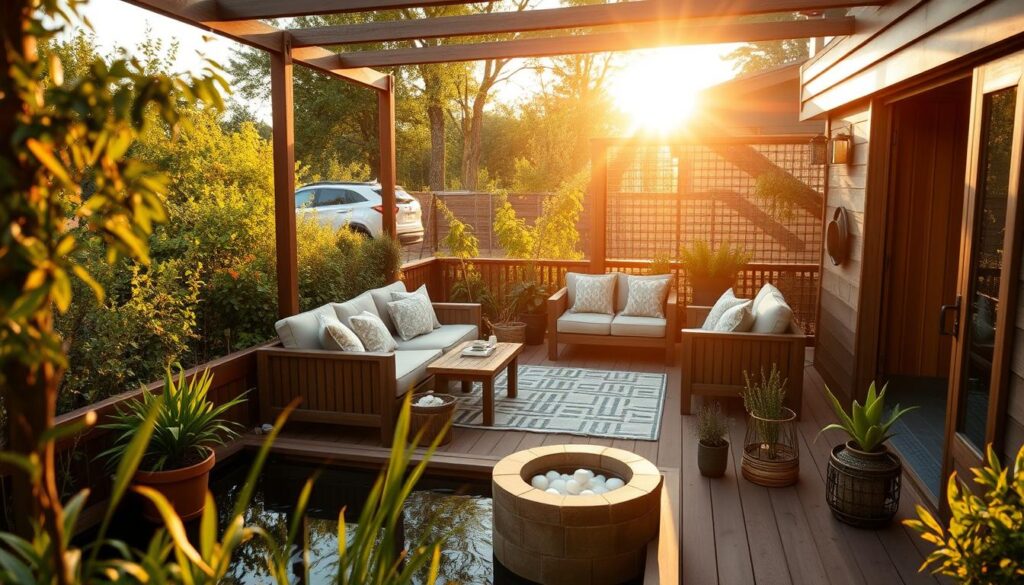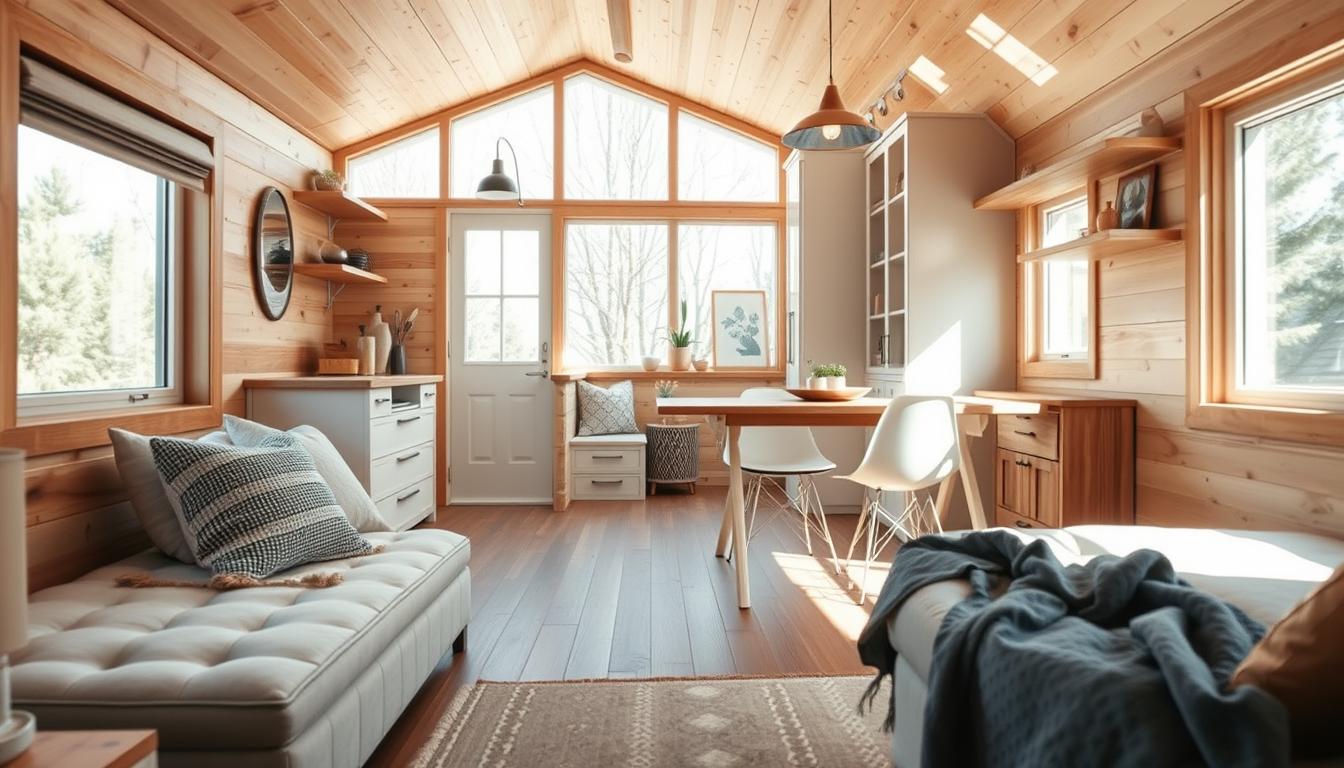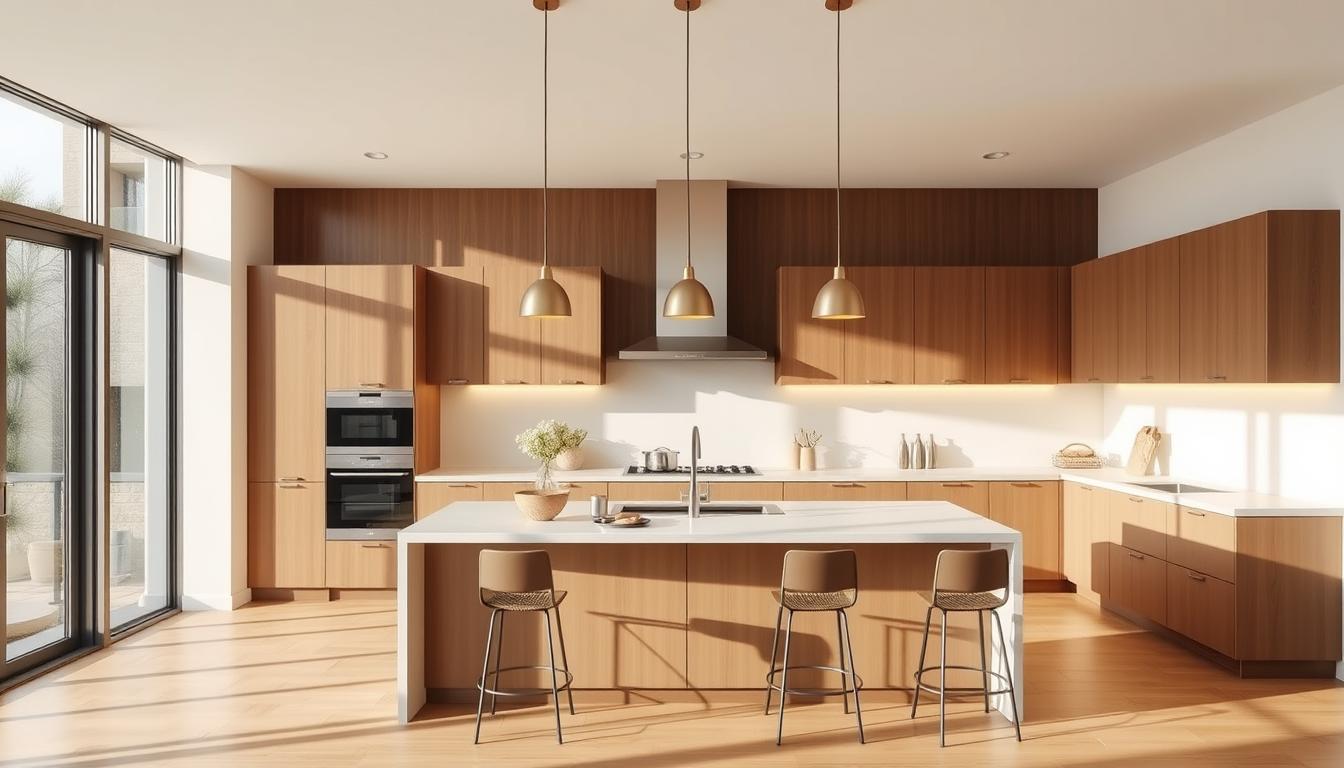Tiny home interiors are getting more popular with the rise of minimalism and sustainable living. Did you know the average American throws away about 4.4 pounds of trash daily? Living in a tiny home can greatly cut down on this waste. By using small space design, people can reduce their environmental impact and create a tidy, efficient home.
Designing tiny homes is all about making the most of every inch without losing style. We’ll share our best tips for this balance. You’ll learn about smart space planning and how to use technology to your advantage.
Key Takeaways
- Maximizing space through efficient design
- Importance of multi-functional furniture
- Utilizing vertical space effectively
- Smart technology for enhanced living
- Aesthetic considerations for tiny homes
Understanding the Appeal of Tiny Homes
The tiny home movement has won many hearts with its promise of simplicity and sustainability. It’s clear that tiny homes offer more than just being small.
Tiny homes let us rethink our relationship with stuff and the environment. By choosing minimalist living, we can cut down our ecological footprint. This lifestyle makes our living space more organized and helps us appreciate the basics more.
The Benefits of Living Tiny
Living in a tiny home means living more intentionally. Every item and space has a purpose. This space-saving approach reduces clutter and encourages mindful resource use. Tiny home residents often feel more free and flexible.
Sustainability and Eco-Friendliness
One big plus of tiny homes is their sustainability. They need fewer resources to build and maintain than big houses. Many tiny home owners also choose eco-friendly materials and renewable energy, lowering their environmental impact.
Cost-Effectiveness in Housing
Another benefit of tiny homes is their cost-effectiveness. They cost less to build and maintain, leading to lower utility bills. This makes tiny homes a smart choice for saving on housing costs. It’s a big plus for those wanting to use their money more wisely.
Exploring tiny homes shows their appeal is in both practical benefits and the lifestyle they support. By living minimally and sustainably, tiny home dwellers enjoy a streamlined, affordable, and eco-friendly life.
Maximizing Space in Tiny Homes
Effective space utilization is key in tiny homes for a cozy and functional living space. We must be creative and strategic in our design choices. This ensures we make the most of the limited space.
Importance of Space Planning
Space planning is the base of a well-designed tiny home. It involves carefully planning the layout to make sure every area has multiple uses. This approach helps create a sense of spaciousness and functionality.
To achieve this, we must think about our needs and what activities will happen in the home. This helps us allocate space well, ensuring important functions are comfortable.
Using Multi-Functional Furniture
Multi-functional furniture is a big help in tiny home design. Items like sofa beds, storage ottomans, and foldable tables reduce clutter and boost space usability. By picking furniture that does more than one thing, we greatly improve our tiny home’s functionality.
For example, a storage coffee table can hold books, magazines, and other essentials. This keeps the floor clear and makes the space feel more open.
Vertical Storage Solutions
Vertical storage is another smart way to maximize space in tiny homes. Using wall-mounted shelves, hanging organizers, and tall storage units keeps things organized and out of the way. This makes the floor space feel more expansive.
It’s also smart to think about hidden storage, like under-bed storage or secret cabinets. These keep valuable or less-used items safe and out of sight.
Color Schemes that Enhance Interiors
In tiny homes, color schemes do more than look good. They help make the space feel bigger and more welcoming. The right colors can make your home feel spacious and inviting.
Choosing Light Colors for Illusion of Space
Light colors on walls and ceilings make tiny homes feel bigger. White, cream, and light gray are favorites because they reflect light. Using light colors everywhere helps your home feel connected and open, making it seem larger.
- Soft whites and creams
- Light grays and blues
- Pale pastels
Incorporating Accents for Personality
While light colors make space feel bigger, accents add personality. Accent walls, furniture, and decor in bold colors or patterns bring warmth and character. It’s key to balance these accents with light colors to avoid feeling too busy.
- Choose one or two accent colors
- Use accents sparingly in furniture and decor
- Consider the 60-30-10 rule: 60% light color, 30% secondary color, 10% accent color
The Power of Natural Light
Natural light is a game-changer for tiny home interiors. It brightens the space and makes it feel larger. Maximizing natural light with big windows, skylights, and mirrors greatly improves your home’s feel.
- Install large windows or sliding glass doors
- Use skylights or solar tubes to bring in natural light from above
- Strategically place mirrors to reflect natural light
Essential Furniture for Tiny Homes
Furnishing a tiny home needs careful thought to use space well. The right furniture can make a small area cozy and useful.
Selecting Compact Furniture Options
Choosing furniture for a tiny home means picking compact and multi-functional items. Compact furniture saves space and keeps things tidy. Look for sofas that turn into beds or tables that fold up.
A storage ottoman can be a coffee table, a place to sit, and storage all at once. Such space-saving solutions are key in tiny homes where every inch matters.
Prioritizing Comfort and Functionality
While it’s key to be compact, comfort and function are also vital. Your furniture should fit well and make your tiny home more livable. For example, a small sectional sofa can be stylish and comfy.
Also, think about how your furniture will flow in your space. Make sure it allows for easy movement and doesn’t feel too tight. Functionality should guide your furniture choices.
Custom-Built Solutions for Unique Spaces
Off-the-shelf furniture might not fit your tiny home perfectly. That’s where custom-built solutions shine. Custom furniture is made to fit your space exactly, using every corner.
Custom pieces, like tailored shelving or storage, can really improve your tiny home’s look and use. Getting a pro to design custom furniture is a smart move.
The Role of Smart Technology
Smart home features are changing tiny homes into efficient and safe places. By adding technology to every part of the home, we can make our lives better.
Integrating Smart Home Features
Adding smart home features to tiny homes makes living easier and more efficient. We can control lights, temperature, and entertainment from anywhere. This makes managing our daily lives simpler.
Some key smart home features include:
- Voice-controlled assistants
- Smart thermostats
- Automated lighting systems
- Smart security cameras
Energy Efficiency Solutions
Energy efficiency is key in tiny home living. Smart tech helps us watch and cut down energy use. This makes our homes greener.
| Energy Efficiency Solution | Description | Benefits |
|---|---|---|
| Smart Thermostats | Learn your temperature preferences and adjust | Lower bills, more comfort |
| Energy Monitoring Systems | See your energy use in real-time | Know how much you use, waste less |
Enhancing Security in Tiny Spaces
Security is a big deal for tiny home owners. Smart tech gives us advanced security features. This makes us feel safer.
Smart tech improves security in many ways:
- Remote control smart locks
- Security cameras with motion alerts
- Alarm systems that warn us of dangers
By using smart technology, we can make our tiny homes more efficient, safe, and cozy. This improves our life quality. It also supports minimalist living and efficient home organization.
Creating a Cohesive Design Theme
Tiny homes need a mix of style and function to feel cozy and open. A unified design theme is key, linking all parts for a smooth look.

Choosing a design style that fits your taste is vital when designing a tiny home. Popular styles include modern minimalist, rustic charm, and industrial chic. Each style can be tailored to fit tiny homes’ small size.
Popular Design Styles for Tiny Homes
Modern minimalist design is all about simplicity and clean lines. It often uses a single color to make spaces look bigger. Rustic charm adds warmth with natural materials and earthy colors. Industrial chic brings character with exposed brick and metal.
“A successful tiny home design is about showing your personality and meeting your needs,” says a top interior designer. This highlights the need to mix personal style with function, making the design both beautiful and useful.
Blending Personal Style with Function
Choosing furniture and decor that does double duty is crucial. For example, a storage ottoman can be a seat and a storage spot. This keeps the space tidy while adding your personal touch.
The Importance of Consistency
Consistency is vital for a unified design. Stick to a color scheme, texture, and style throughout. This creates a sense of flow and makes the space feel bigger and more welcoming.
By picking a design style, mixing personal taste with practicality, and keeping things consistent, you can make a tiny home that looks great and works well. As we dive deeper into tiny home design, it’s clear that a well-planned design theme is crucial for these small spaces.
Efficient Kitchen Designs
Creating a kitchen in a tiny home needs creativity and careful planning. We must find ways to use space wisely and make the kitchen both functional and comfortable.
Space-Saving Appliances and Fixtures
Choosing the right appliances and fixtures is a big challenge in tiny home kitchens. Opting for compact appliances is a smart move. For example, a narrow refrigerator or a two-burner stovetop saves a lot of space.
Also, using wall-mounted faucets and foldable kitchen tables adds to the kitchen’s efficiency.
Smart Layouts for Tiny Kitchens
The kitchen’s layout is very important in tiny homes. A galley kitchen layout or an L-shaped kitchen works best. These layouts help in moving around easily and fit all the necessary items.
Adding creative storage solutions like under-sink storage or overhead cabinets keeps things tidy.
Organization Tips for Small Kitchens
Keeping a tiny home kitchen organized is essential. Using drawer dividers, spice racks, and magnetic strips helps keep things in order. A “zone” system for cooking, preparation, and storage also boosts efficiency.
By focusing on space-saving designs, smart layouts, and good organization, we can make a tiny home kitchen both efficient and pleasant. Whether it’s for a simple meal or a big gathering, a well-designed kitchen makes a big difference.
Designing Functional Bathrooms
Tiny home bathrooms need to be both stylish and practical. It’s important to find a balance between looks and function.
Compact Bathroom Fixtures
Choosing the right fixtures is key in tiny home bathrooms. Wall-mounted sinks and toilets save space and make the area feel bigger. Compact shower units also help by replacing big bathtubs.
Maximizing Storage in Bathrooms
Storage is crucial in tiny home bathrooms. Using vertical space with tall cabinets or shelves boosts storage. Recessed medicine cabinets are smart for storing things without taking up floor space.
| Storage Solution | Description | Benefits |
|---|---|---|
| Vertical Cabinets | Tall, narrow cabinets that use wall space | Maximizes storage without taking up floor space |
| Recessed Medicine Cabinets | Cabinets recessed into the wall | Provides storage without protruding into the room |
| Over-the-Toilet Storage | Shelves or cabinets above the toilet | Utilizes waste space |
Stylish Yet Practical Designs
Making a tiny home bathroom stylish is about more than just function. It’s about creating a beautiful space too. Using light colors on walls and fixtures makes the bathroom look bigger. Adding mirrors also makes the space feel larger and adds style.
By picking the right fixtures, maximizing storage, and adding stylish touches, you can make a tiny home bathroom both beautiful and practical.
Integrating Outdoor Spaces
Making indoor and outdoor spaces work together can really make a tiny home feel bigger and more welcoming. It’s all about creating a smooth flow between the two.

Creating an Outdoor Living Area
An outdoor living area can make your tiny home feel much bigger. Use furniture that does more than one thing, like a bench that also stores things or a table with built-in planters.
Choose furniture that’s tough and can handle the weather. Recycled plastic, teak, or metal are great because they last long and need little care.
Indoor-Outdoor Flow
It’s important to make moving between inside and outside easy. Big sliding glass doors or folding doors can help make your home feel bigger.
Use the same flooring or colors inside and out to make the transition smoother. This helps your home feel more connected and peaceful.
Choosing Durable Outdoor Furnishings
Outdoor furniture needs to be tough to last. Look for pieces made from materials that can handle the weather. Also, think about how easy they are to keep clean so they stay looking good.
| Material | Durability | Maintenance |
|---|---|---|
| Recycled Plastic | High | Low |
| Teak | High | Medium |
| Metal | High | Low |
By using these tips, you can make your tiny home feel more open and inviting. It’s all about blending indoor and outdoor spaces for a better living experience.
Personalizing Your Tiny Home
Turning a tiny house into a home that shows your personality is key. Adding elements that speak to you makes your space welcoming and uniquely yours.
Adding Custom Artwork and Decor
Custom artwork and decor are simple ways to make your tiny home personal. You can choose pieces from local artists, family photos, or items from your travels. Custom artwork adds visual interest and tells your story, making your space feel personal.
For more inspiration, check out our guide to designing tiny home interiors.
“The home should be the treasure chest of living.” –
Utilizing Family Heirlooms
Adding family heirlooms to your tiny home decor is meaningful. These items hold sentimental value and add history and character to your home.
- Display cherished items on shelves or in glass-front cabinets.
- Use vintage furniture pieces passed down through generations.
- Incorporate heirloom quilts or textiles into your decor.
The Impact of Textures and Fabrics
Textures and fabrics add depth and warmth to your tiny home. Mixing different textures creates a cozy and visually appealing atmosphere.
| Texture | Examples | Effect |
|---|---|---|
| Smooth | Leather, metal | Modern, sleek |
| Rough | Wood, stone | Natural, earthy |
| Soft | Fabrics, rugs | Cozy, inviting |
By adding custom artwork, family heirlooms, and a mix of textures and fabrics, you can make your tiny home personal and inviting.
Lighting Tips for Tiny Interiors
The right lighting can transform a tiny home into a cozy and inviting space. We’ll look at how to design your lighting for a brighter, more welcoming home.
Layered Lighting for Versatility
Layered lighting uses various light sources for a flexible scheme. This includes overhead lights, table lamps, and floor lamps. It lets you change the mood of your tiny home for different activities.
For instance, dimmer switches can adjust the light’s intensity. This creates a cozy feel for relaxing or a brighter light for reading or cooking.
Using Natural Light to Your Advantage
Natural light is key in tiny homes, making them feel larger and more welcoming. Use sheer curtains or blinds to let sunlight in while keeping privacy.
Also, place mirrors opposite windows to reflect natural light. This spreads it evenly throughout your tiny home.
Selecting Energy-Efficient Options
Energy efficiency is vital in tiny homes, where resources are limited. LED lighting is a smart choice, using less power and lasting longer than traditional lights.
Look for lighting with energy-efficient certifications like ENERGY STAR. This ensures your lights save energy and meet quality standards.
| Lighting Type | Energy Efficiency | Cost-Effectiveness |
|---|---|---|
| LED Lighting | High | Long-term savings |
| Incandescent Lighting | Low | Higher utility bills |
| Smart Lighting | High | Initial investment, long-term savings |
By using these lighting tips, you can make your tiny home more efficient and beautiful. It becomes a more enjoyable and functional space.
Maintaining a Clutter-Free Environment
When we design tiny homes, we focus on efficient kitchens, functional bathrooms, and outdoor spaces. Keeping these areas clutter-free is key for a peaceful life. We aim for a minimalist lifestyle, which means organizing and decluttering well.
Effective Organizing Strategies
To keep a tiny home tidy, we use smart storage and regular cleaning. This includes multi-functional furniture, vertical storage, and seasonal clean-outs. These steps help us manage our belongings effectively.
Seasonal Clean-Outs and Storage
Seasonal clean-outs help us review our belongings and keep things balanced. By storing items properly and only keeping what’s needed, we keep our tiny home serene.
Adopting the Minimalist Mindset
Living minimally means being careful about what we buy and what we keep. This approach helps us create a peaceful, clutter-free space. It improves our well-being in our small home.



